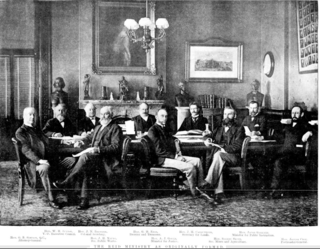Members of the New South Wales Legislative Assembly who served in the first parliament of New South Wales held their seats from 1856 to 1858. </ref> The Speaker was Sir Daniel Cooper.
The Donaldson ministry was the first ministry of the Colony of New South Wales, and was led by Stuart Donaldson. Despite the first free elections for the New South Wales Legislative Assembly being held in March 1856, it took over two months for Donaldson to form Government. It was sworn in on 6 June 1856, after the 1856 election and lasted just eighty days.
The Parker ministry was the third ministry of the Colony of New South Wales, and was led by Henry Parker. Parker was elected in the first free elections for the New South Wales Legislative Assembly held in March 1856 and, following the failure of the Donaldson and Cowper Governments to maintain the confidence of the Assembly, was asked to form Government.
The second Cowper ministry was the fourth ministry of the Colony of New South Wales, and second occasion of being led by Charles Cowper.
The Forster ministry was the fifth ministry of the Colony of New South Wales, and was led by William Forster. Forster was elected in the first free elections for the New South Wales Legislative Assembly held in March 1856. He was asked to form Government after the second Cowper ministry lost an educational bill in the Assembly.
The first Robertson ministry was the sixth ministry of the Colony of New South Wales, and was led by John Robertson. It was the first of five occasions that Robertson was Premier. Robertson was elected in the first free elections for the New South Wales Legislative Assembly held in March 1856.
The third Cowper ministry was the seventh ministry of the Colony of New South Wales, and third occasion of being led by Charles Cowper.
The first Martin ministry was the eighth ministry of the Colony of New South Wales, and first occasion of being led by James Martin QC.
The fourth Cowper ministry was the ninth ministry of the Colony of New South Wales, and fourth occasion of being led by Charles Cowper.
The second Martin ministry was the tenth ministry of the Colony of New South Wales, and second of three occasions of being led by James Martin QC.
The second Robertson ministry was the eleventh ministry of the Colony of New South Wales, and was led by John Robertson. It was the second of five occasions that Robertson was Leader of the Government. Robertson was elected in the first free elections for the New South Wales Legislative Assembly held in March 1856.
The fifth Cowper ministry was the twelfth ministry of the Colony of New South Wales, and the fifth and final occasion of being led by Sir Charles Cowper.
The third Martin ministry was the thirteenth ministry of the Colony of New South Wales, and the third and final occasion of being led by Sir James Martin.

The Reid ministry was the 28th ministry of the Colony of New South Wales, and was led by the 12th Premier, George Reid. The title of Premier was widely used to refer to the Leader of Government, but was not a formal position in the government until 1920. Instead the Premier was appointed to another portfolio, usually Colonial Secretary but on this occasion Reid took the portfolio of Colonial Treasurer until July 1899 and then Attorney General.
The 1856 New South Wales colonial election was to return 54 members of Legislative Assembly composed of 34 electoral districts with 18 returning 1 member, 13 returning 2 members, two returning 3 members and one returning 4 members, all with a first past the post system. In multi-member districts, because each voter could cast more than one vote, it is not possible to total the votes to show the number of voters and voter turnout in these districts is estimated. 8 members from 6 districts were returned unopposed.
Sydney City, an electoral district of the Legislative Assembly in the Australian state of New South Wales, had two incarnations, from 1950 until 1971 and from 1988 until 1999.
East Sydney, an electoral district of the Legislative Assembly in the Australian state of New South Wales was created in 1859 and abolished in 1894.
A by-election was held for the New South Wales Legislative Assembly electorate of East Sydney on 17 February 1865 because Charles Cowper had been appointed Premier and Colonial Secretary, forming the fourth Cowper ministry. Such ministerial by-elections were usually uncontested however on this occasion a poll was required in East Sydney, The Glebe and West Sydney. Each minister was comfortably re-elected. Only The Paterson was uncontested.
A by-election was held for the New South Wales Legislative Assembly electorate of Sydney Hamlets on 17 June 1856 because Stuart Donaldson was appointed Colonial Secretary forming the Donaldson ministry. Under the constitution, ministers were required to resign to recontest their seats in a by-election when appointed. Of the other ministers, John Darvall comfortably won the by-election for Cumberland North Riding. Thomas Holt and Bob Nichols were re-elected unopposed. William Manning was not required to resign as he held the office of Solicitor-General at the time of his election.
A by-election was held for the New South Wales Legislative Assembly electorate of Sydney Hamlets on 10 October 1856 because Stuart Donaldson was appointed Colonial Treasurer in the Parker ministry. Under the constitution, ministers were required to resign to recontest their seats in a by-election when appointed. Of the other ministers, Henry Parker narrowly won the by election for Parramatta. John Darvall comfortably won the by-election for Cumberland North Riding, and William Manning comfortably won the by-election for Cumberland South Riding. Only John Hay (Murrumbidgee) was re-elected unopposed.


